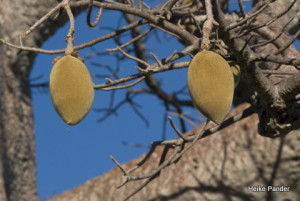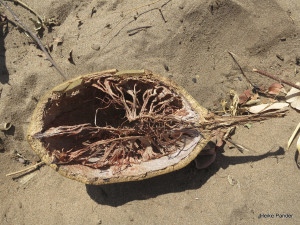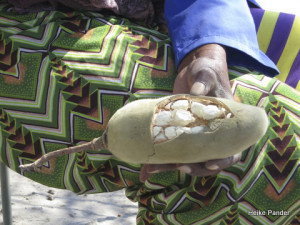The flowering period of the Baobab often begins with the onset of the rainy season and lasts about six weeks. Thereafter, Baobab fruit begin to grow. Alike the flowers they hang pendulous off the branches on long pedicels. At first, the fruit usually have a yellowish colour. At a later stage of the ripening process the colour changes to green or brownish grey. The outer shell of the fruit is covered with a layer of yellow-brown hair that feels velvety to the touch. The pericarp or better known as the shell of the fruit is about 5 Millimetres thick. This varies from region to region and can be up to 10 Millimetres thick as seen in Zanzibar.
The shape of the fruit varies greatly, too – from round to oblong-cylindrical. The fruits reach a length of up to 54 Centimetres and are about 20 Centimetres wide. Depending on the region and location of the trees they start flowering for the first time between 15 and 25 years of age. More than 250 fruit can be harvested of adult trees.
On the inside red-brown and coarse fibres crisscross the fruit and hold the creamy-powdery fruit pulp. Its colour varies from cream to pink. Therein lie the kidney-shaped and up to one Centimetre large seeds. A fruit can contain an average of 250 seeds and consists of approximately 15% pulp, 40% seeds and fibres and 45% pericarp.
The ripening of the fruit takes about half a year. During this time, the fruit pulp dries naturally in the pericarp. When the fruit are ripe, they fall to the ground. With this their outer shell sometimes cracks and allows little animals easy access to the otherwise tough to open fruit.
Baobabs usually do not grow on plantations. The fruit are therefore often referred to as wild collections. Local people collect the fruit and further process them once they fall off the tree. The wild fruit are not a product of agriculture and therefore in most cases “bio” by nature. The fruit powder has a slightly sour-fruity taste, comparable to that of citrus fruits.
What is so special about baobab fruits?
Baobab fruits are internationally traded as “super fruit” or “super food” like acai berries and goji berries. Their mix of ingredients makes them special:
The fruit can contain up to ten times as much fibre as apples, up to six times as much vitamin C as oranges, up to six times as many antioxidants as blueberries, up to five times as much magnesium as avocados, up to four times as much potassium as bananas and up to twice as much calcium as milk, even more iron than meat – just to name a few. This outstanding mix is supplemented by representatives of the B vitamins and various omega fatty acids. The concentration of the ingredients in the fruit varies according to their place of origin.
Ingredients:
• Sugar: sucrose, fructose, glucose (30 % of the carbohydrates)
• Dietary fibre: for example Pectin, (70% of the carbohydrates)
• Citric, malic, tartaric and ascorbic acid (vitamin C, 300 mg/100g)
• Proteins: contains a total of about 3% of all essential amino acids
• Minerals: a total of approximately 6 %, a particularly high degree of calcium (about 300mg/100g) and potassium (up to 3 mg/100g)
• Vitamins B1, 2, 3 und 6
• Fat: < als 1 %






Pingback: Baobab Fruit Powder – Wild Collections - Baobabs
Pingback: Baobab Fruit as Birdhouses! - Baobabs
Pingback: Baobab Fruit as Birdhouses! – Baobab
Pingback: Baobab Fruit Powder – Wild Collections – Baobab
Pingback: Baobab deco - beautiful and useful - Baobab
Pingback: How Can You Harvest Baobab Fruit?